|
FAQs about Stony Coral Health/Disease/Pests 13
Related Articles: Coral Pests and Disease; pests, predators,
diseases and conditions by Sara Mavinkurve,
Quarantine of Corals
and Invertebrates, LPS
Corals, True or Stony Corals, Order
Scleractinia, Propagation for Marine
Aquarium Use,
Related FAQs: Stony Coral Disease 1, Stony Coral Disease 2, Stony Coral Disease 3, Stony Coral Disease 4, Stony Coral Disease 5, Stony Coral Disease 6, Stony Coral Disease 7, Stony Coral Disease 8, Stony Coral Disease 9, Stony Coral Disease 10,
Stony Coral Disease 11, Stony Coral Disease
12, Stony Coral Disease 14,
Stony Coral Disease 15,
FAQs on Stony Coral Disease by Category: Diagnosing:
Environmental (Pollution/Poisoning, Lighting...),
Nutritional, Social (Allelopathy),
Trauma,
Pathogenic (Infectious, Parasitic, Viral)
Predatory/Pest,
Treatments
FAQs on Stony Coral Disease by Family: Acroporid Disease, Acroporid Disease 2, Acroporid Disease 3, Acroporid Disease 4..., Caryophyllid Disease, Caryophyllid Disease 2..., Elegance Coral Disease/Pests, Dendrophylliid Disease, Faviid Disease, Faviid Disease 2, Fungiid Disease, Mussid Disease, Mussid Health 2, Poritid Health, Trachyphylliid Disease, Trachyphyllia Disease 2,
FAQs on Stony Coral Disease by Type: Brown Jelly Disease, RTN,
|
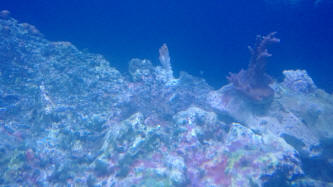
|
|
Slime everyday 2/17/16
I got this not sure what its called
<Always better to i.d. before you add it to your tank.>
but everyday since i got its slimes some. The polyps do extend out
<Good, good. How long has it been in place in the tank?>
but the slime is always coming out mostly in mornings. Could fish swimming by an
making them retract be the problem?
<This or another source of irritation can cause this sort of mucus to form.
However it's not at all unusual, especially as you mention that it seems to be
there mostly in the morning. I would be that it happens at night, and you are
seeing the remnants. A look-see into the tank at night would be educational here
and is always something interesting to do in any case. So much of what goes on
with coral happens at night when we aren't seeing it. I suggest a small
flashlight pointed indirectly, or just some moonlights/blue, subdued lights.
This could be feeding behavior, illness or irritation, or just sloughing
off mucus layers as a cleaning mechanism. In any event, monitor it
frequently, IDENTIFY it as soon as possible (WWM is full of articles on I.D. as
are some books I consider must-haves...Book of Coral Propagation comes to mind).
See if it seems to thrive or seems to deteriorate. -Earl>
|
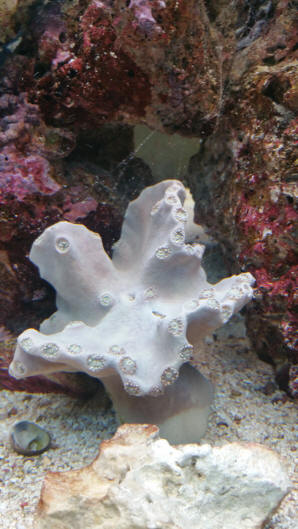 |
|
Corals dying?
10/16/15
Hi we have a 50 gallon salt water tank with a couple of corals. In the past
you have been helpful in our attempts at maintaining a tank, but now we have
some ailing corals. Pictures are attached.
<Mmm; something wrong here; starved?>
We have razor LED lights set to 35% W + 55% B for 7 hrs/day and are getting PAR
readings in the 60-90 range at the corals (depending on the orientation of the
sensor).
<A bit low... I'd "move them up" to shallower water till you were at 100 plus>
These pictures were taken in the evening after the lights had started to
progress back to night (they go to 0 at night), so the
pictures are more blue than the day. We do weekly 5% water changes and have
measures that are stable:
pH = 8.3
Ammonia < 0.2 mg/L
Nitrite = 0 mg/L
Nitrate < 10 mg/L
Phosphate <0.15 mg/L
Calcium > 420 ppm
Alkalinity > 15 dKH
Our cup coral was starting to retreat from its sides so we started turning up
the lights. When it hit 50% W + 50% B, we spoke to someone at our local
saltwater fish store who suggested that the W was too high and we have turned
the W back down. But our cup started retreating massively and now our (elephant
ear?) mushroom coral (which had been extremely healthy)
started to become covered with the same dark algae.
<Trouble.... have you felt this algae? Is it very slimy? Could be that BGA
poisoning is a factor here>
The areas covered with algae are very hard (I know not to touch the soft coral
parts).
Thank you
David and Laura Redish
<Mmmm; well; something not mentioned is trouble here. Do you use chemical
filtrants? What do you feed these corals? What other life is present?
Bob Fenner>
|
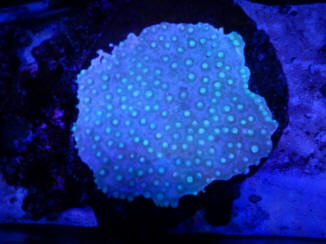
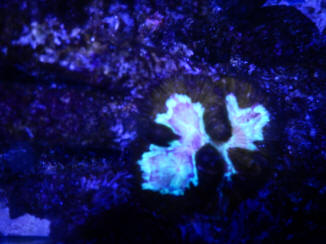 |
|
Re: Fwd: Corals dying?
The corals were doing better until we turned the lights up.
<Ah, I'd "turn them back up"; as prev. stated>
We turned the lights up at 2% per week. But turned it back down when they
started to shrink. But now they're shrinking fast.
Algae is not slimy at all. Generally feels more like rock than slimy algae. It's
as if the corals are simply shrinking.
<I'd still be using GAC, Polyfilter, spiffing up your skimmer, CHECKING
REDOX.... READING on WWM re toxic Algae and its control>
Other life in the tank: 2 clown fish, 1 one-spot foxface rabbit fish, 1 blue
Chromis,
<Social species>
1 Hawkfish, plus small generally good stuff hidden in our rocks - small
feather-dusters, a few of those strawberry anenomes,
<Stop! There is good reason to be concerned re these and....>
some hidden yellow sponges
<these sponges as sources of allelopathy. See the search tool on every page on
WWM? Use it re these animals and the term>
under the rocks, but nothing near either large coral. (Is a very mature tank,
been around for more than six or seven
years.) None of the other life looks unhealthy. Fish all look great.
We feed the tank a small cube of mysis shrimp daily which gets eaten by the
fish. Is there something more we should be giving the corals?
<...? Yes.... STOP writing and start READING>
We haven't fed them for years. The elephant ear coral was healthy until very
recently (>5 years).
Re: BGA poisoning. We don't see anything slimy on the walls of the tank or the
rocks, but I have been noticing what looks like dust or paint on the top of the
tank, at the juncture of the water and the air. It's very thin and fine and I've
tried to scoop it out, but it just dissipates back into the water. If
there was BGA poisoning, what could be done about it?
<....? You're joking? Instead of READING>
I'm not sure what you mean by chemical filtrants.
<....>
We have a canister filter, which we change regularly every 5-6 weeks.
Nothing has changed in that (in terms of slimy algae or anything). Algae and
worms and snails in that appear normal.
thanks
|
Halofolliculina corallasia
7/27/15
Pretty sure I've got this little bugger in one of my coral frag tanks
(Halofolliculina corallasia). It has been taking out corals like crazy.
Checked it out under a microscope after dipping the corals (thinking it was
black bugs) to discover it didn't look like a crustacean at all but rather a
tube or poop. After reading this article I'm pretty confident in my diagnosis,
however can't find any information about what to do. As of right now we are just
disposing of dead corals using disposable gloves so that we don't spread it
around. Any thoughts?
Matt
<For browsers, the quick wiki:
https://en.wikipedia.org/wiki/Halofolliculina_corallasia
I'd be treating either the system or the moved/enroute corals with a quinine
compound to kill this Heterotrich. My first choice is Chloroquine (di)phosphate.
See WWM re dosages, protocols. Bob Fenner>
Re: Halofolliculina corallasia
7/28/15
Thanks for the reply Bob. Searched for the dosages and protocols and didn't find
much re: corals other than CP is harmful and that corals should be removed when
treating fish. Also searched the web at large for using CP
on corals and didn't find much there either. I do have CP at my disposal in good
quantity and would love to start saving some corals. Perhaps you can provide
more guidance...
I'm presuming this is a dip scenario
Mg/liter?
<I'd stick with the same maximum as per system treatment 20 mg/l>
Duration of dip?
<Half an hour... with spg reduced a thousandth or two... Some folks might add a
good deal of iodide-ate and perhaps several mg/l of a hexose sugar>
Repeated dips required?
<Possibly; but not usually>
Will I be able to tell if the protozoa are dead after dip by looking at them
under the scope (They always appear dead to me)?
<You should... try adding a drop of household strength H202 to the cover slip
edge. Should move them if alive>
I've read multiple sources say it spreads through direct contact. Should I be
concerned about it traveling around on egg crate?
<Yes; anything wet is suspicious>
Are you aware of any natural predators, maybe a shrimp of some sort?
<I am not>
Matt
<Bob Fenner>
Re: Halofolliculina corallasia (Holotrich parasite of Scler)
9/10/15
Just thought I'd follow up for other readers to confirm that this dip was
successful.
<Ahh! And thank you for your report/follow-up>
So far we are at about 6 weeks with no recurrence after a single dip done for
the most part as you suggested. 20mg/l in slightly reduced alkalinity <salinity?
really spg> with the addition of Lugol's solution. I skipped the sugar as I
didn't have any on hand and couldn't find any at the grocery store). We ended up
doing a longer length dip, after looking at the critter under the microscope
after half an hour (with a touch of alcohol also as you suggested) they were
quite wiggly. So we ended up doing closer to an hour, however, after looking at
them again under the microscope they were still quite wiggly so I think it was
actually just too much activity from the alcohol making them look alive. I'm
still not sure on that one.
There was one we had under the scope whose tube appeared to poop when we added
the drop of alcohol, not sure if that was one of the buggers dying or some other
microscope foible. Anyway, appreciate the solution,
Matt
<Again, appreciated. Bob Fenner>
Re: Halofolliculina corallasia 9/10/15
Haha. Yes... spg. Not alkalinity.
<Ahh. B>
Re: Halofolliculina corallasia
12/19/15
We had a discussion a while back about this nasty critter.
<I do recall>
I reported dips in Chloroquine Phosphate successful but that success was short
lived. We've been battling this like crazy with recurring dips which seem to
slow it down, but don't seem to kill it off. I'm guessing this has to do with
lifecycle but I can't find any information on lifecycle or life stages.
<Mmm; have you looked re "related" organisms? Other Heterotrich, Scuticociliatia
?
See these for input:
http://www.ncbi.nlm.nih.gov/pmc/articles/PMC2227702/
http://www.zoology.ubc.ca/courses/bio332/Lectures/Ciliates/ciliate_life_cycle.htm>
We've expanded our dipping to two hours just to increase exposure time.
I'm not sure the impact on the corals. I don't really see a difference between
doing it for 2 hours or 30 minutes in terms of coral health, as they always seem
to eventually succumb to the ciliate eventually. The ciliate most definitely
targets weaker corals, for example we dipped a large number of Montipora in
Potassium Permanganate which has been quite successful in the past for
eliminating Nudibranchs.
<A strong oxidizer... am wondering (so am writing) if concentrated H202 might
work, be less harsh>
It takes the Montipora several weeks to recover but they usually do. This last
time, only a small fraction recovered. The ones we lost were all covered in H.
corallasia. Removing the infected area helps to some degree.
I pulled a large number of infected corals out, chopped off infected areas,
dipped them in Chloroquine, then put them in quarantine for about a month. I
moved them to the main system and within a month they were all infected again
after apparently doing well in the quarantine.
Unfortunately there are so many variables I can't figure out what's working and
what's not. Do you have any other ideas or thoughts?
<Would soaking the CP in with foods the corals will take be another avenue?
Do you lower the spg (a few thousandths) in the dip water; AND add a hexose
sugar while doing the baths? I would. Bob Fenner>
Matt
Re: A prob. protozoan; your input please /Jake Adams
12/21/15
Halofolliculina is not a parasite in the classic sense. It seems to be
an opportunistic coral irritant that only grows on the edges of corals margins.
It seems to colonize only on slightly unhealthy corals. Instead of dipping like
crazy, I recommend cutting the healthy part of the frag and throwing out the
rest. Meanwhile, be more generous with your spectrum of trace element addition,
Iodine, Fluoride, Iron, Boron, Zinc, Molybdenum and Manganese to encourage more
robust tissue in the coral and much faster encrustation.
<Thanks Jake. BobF>
|
Frogspawn issues
I noticed on Euphylliid health on your website about pests and parasites and
different solutions. I have not noticed any hitchhikers. The thing I
noticed that my nitrates are high
<How high is high?>
and that I changed over to a max gyre wave maker and ever since that I noticed
the frogspawn respond differently in that it has not all bloom as nice as
before. The wave is not so high to put a lot of current on the frogspawn section
that is being effected. These are a few more different pics that might
be able to help with my issue.
<See some dead heads... long since>
Also I noticed last night a small piece of frogspawn tips on the sand bed.
<Happens; a type of "bail out".... specimen-saving behavior.... escape mechanism
from poor conditions locally. You need to find out what these "poor cond.s"
are... Too little of something/s, too much of...?>
Could it be a fish picking at it.
<Doubtful; Euphylliids/Caryophylliids aren't very palatable... too stinging when
healthy>
I have a coral beauty, yellow tang, blue throat trigger bi color blenny and a
melanarus wrasse. Can I send you a video of my tank and maybe that would be more
helpful?
<You can send a link to the video you post on the Net; but again;
something/s wrong w/ the environment here (the list of possibilities is very
long).... When, where in doubt, large changes.... water changes, replacing
substrate, a good deal of new live rock.... best perhaps moving the colony to
some place new that's established (another system)....>
As I said before this frogspawn is about 20 yrs old. It is or was pretty hearty.
Thanks again for your response. I much appreciate it
<I'd be reviewing the environmental diseases of Scleractinians, the
Families therein; posted on WWM.
Bob Fenner>
Frogspawn issue
Oh yeah I forgot. I also use revive coral cleaner
<Don't know much about this>
when I introduce any new corals which everything else is doing real good other
than a section of the frogspawn. Also how would I administer iodide-ate
and hexose sugars?
<See/Read on WWM re... the search tool....>
Do I take the coral out or dose the tank?
<The latter likely>
Thanks,
Vasilios
<Welcome. BobF>
Re: Frogspawn issues
Thanks for the quick response
<Ah, welcome>
|
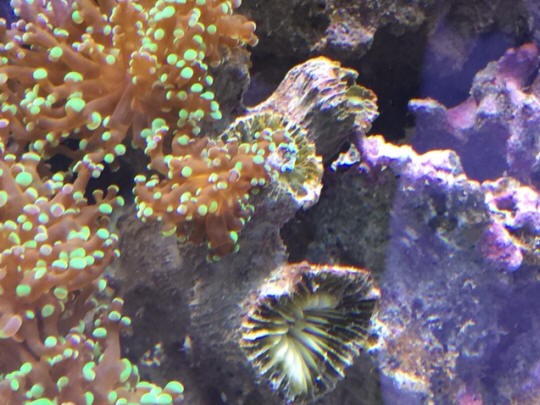 |
|
Re: Frogspawn issues
Hello Mr. fennel. I forgot to mention that I have a purple lobster also a blue
and orange Linckia and yellow mesh starfish. Would they be an issue with the
frogspawn?
<Mmm; not likely. They might be crawling over the colony, but shouldn't result
in the dead areas shown in your pix>
I have had them for a couple of years without problems
Thanks,
Vasilios
Re: Frogspawn issues
Nitrates is 75
<MUCH too high. For reef systems you want to keep [NO3] under 10 ppm maximum.
SEE/READ on WWM re nitrate control.
http://wetwebmedia.com/nitratesmar.htm
and the linked files above. Bob Fenner>
|
|
Problems with online ordered corals
4/10/15
Hello All,
<Vinh>
I hope that everything is well on your side.
<Yes; thank you>
I recently made my first attempt at ordering corals online, and they took bit
longer than anticipated to arrive, about a 24 hour transit because of delays.
<Not atypical; plus who knows how much time in the bag>
I finally received several specimens, but I noticed some problems with some of
the corals that were shipped almost right away. This is how they had arrived.
The torch coral has one dead head.
<See this>
One of the LPS has significant tissue damage, not sure what the cause is.
Another LPS has bleached spots.
My Acropora carduus is bleaching on the tips.
<And all of these>
To try and contain the spread of the damage, should I cut off the parts that are
affected?
<I wouldn't do this... not just yet... Instead the iodide and simple sugar/s
treatment gone over on WWM>
Will this help?
<Not likely.... right now... more probable to cause further stress, troubles>
I've attached some photos for your consideration. I used the recommended
acclimation method from WetWebMedia
as well and they are currently in a quarantine system.
<Ah good.... again, iodide-ate and hexose carbohydrate; perhaps dropping the
spg. a thousandth to induce uptake>
Please let me know what your recommendations are.
<As stated. Bob Fenner> |
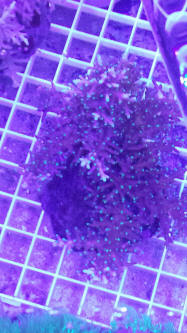
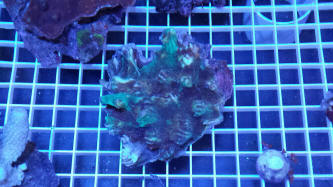
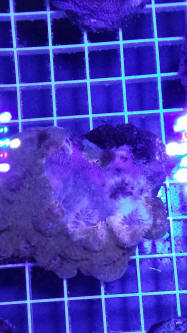
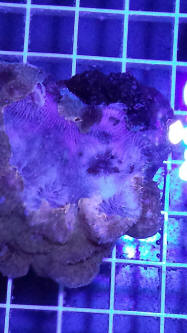 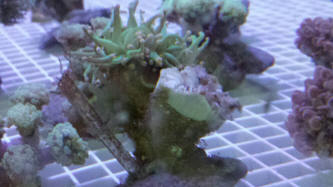 |
Re: Problems with online ordered corals
4/10/15
Hello Bob,
Thank you for your kind reply. I'm terribly sorry but I've done a search on
your website, as well as on Google, but I can't seem to find the article
regarding the directions for performing this treatment.
<Mmm; try the search tool at the top of every page: "Corals Iodine", "Corals
Sugar", then the second search tray to the right w/ just the Iodine or Sugar
word in it. Oh! Tried out myself... some here:
http://www.wetwebmedia.com/iodf2.htm >
I've read through many pages of your FAQs today that have suggestions to add
iodide and a simple sugar, but I was hoping that you had a page with
directions?
<Mmm; not as far as I'm aware>
Would this treatment be performed as a dip?
<Best on the way in from the source. These mat.s are part of my S.O.P. for
the wholesale and collecting sides of the trade>
If you would be able to point me to the right page, (maybe I'm performing
the wrong search) that would be very much appreciated.
<Welcome. BobF>
Re: Problems with online ordered corals
4/11/15
Hello Bob,
<Vinh>
Thanks for sending me the link so much, you and your crew are so dependable and
your advice is always appreciated. I've gone through the page, but I do have two
questions if you don't mind.
1. I acclimated the corals on late Weds. night so they haven't been in the
system for more than 48 hours yet. When should I perform this treatment?
<ASAP>
Right away or wait until the corals settle in a little more.
<Now>
2. How often should I perform this as I read on WWM, that moving the corals 3-4x
per week will surely kill them.
<Doesn't help them to be moved for sure; esp. if not stabilized/healthy.
See the Stony Coral Health FAQs on WWM for much more. Bob Fenner>
Re: Problems with online ordered corals 4/11/15
Also I picked up SeaChem Iodide and glucose from the grocery store like you had
suggested.
<Ah good. You'll be able to see "results" in a few hours.... really. BobF>
|
Re: Problems with online
ordered corals
4/13/15
<Vinh; pls reduce your image file sizes by an order of magnitude and re-send
all>
Re: Problems with online ordered corals
4/13/15
Here you go.
Please let me know if this is better.
<Is; but see our limits re... in "how to write us">
Hello Bob,
I was able to stop some of the RTN on the corals with the treatment
suggested, but some of the corals have gotten worse unfortunately.
I do have a couple more issues with my most recent online shipment that I
would like your advice on.
Here are my parameters
Calcium 460
Magnesium went from 1280 to 1080 after I added the corals Alk 9.8
Salinity
1.23
<likely 1.023; needs to be NSW strength: 1.025-6>
Temp: 76.5
Phosphate: 0
Nitrate: 0
<Chemically starved.... Trouble: ALL life needs some/measurable NO3 and
HPO4... SEE WWM re>
I have a couple of Montipora danaes, are they suffering from brown jelly
disease?
<Maybe>
One of my LPS, the tissue has deteriorated on a part of it, should I perform
the same iodide/glucose treatment?
<Yes; on import; in the process of receiving, acclimation>
I've attached a photo of when I received
it and how it looks now. The photo of when I received it isn't as clear.
For the past treatment, I used my tank water in a 4.5G kitty litter tray.
I
used glucose syrup, since they didn't have it in powder form. As for the
Iodide, it said that 2 drop per 20G tank will increase by .1. My level were
at .6 and I was trying to get to the 5.1 that I had read on one of your
feedbacks, but that was for the for Lugol's treatment though. I used a
squirt which was about 55ML. Does that sound about correct?
<Yes>
Finally, two of the Acros at this point with the bleaching, it seems
to have
some algae taking over.
<Bad>
Should I consider this a loss battle and get him
out of the quarantine so it doesn't do further damage to the other corals?
<Mmm; I'd leave in place and hope for the best. Acroporids are way down on
the scale of "allelopathy">
As always thanks for your input.
<Again; all need to develop and adhere to a strict protocol, S.O.P., in
engaging in importing these animals.
Bob Fenner>
|
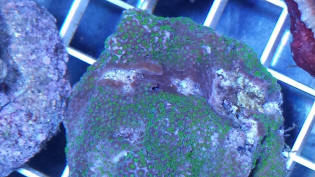
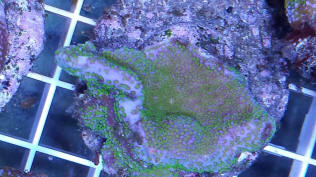 |
|
Re: Issues with corals 1/15/15
The system is twin units each one about 45 gals. all corals have
ample spacing
<.... no: READ on WWM re Allelopathy, SEE my PPT, READ re>
to ensure there are no stinging issues. There were 3 total galaxeas
<Oculinids amongst the worse...>
in the system. Na: was probably present but under 5ppm. the tank does
have substrate and quite a cleanup crew. oversized skimmer. about 520w
total of led lighting.
<Worthless non-information. What re PAR, PUR readings?
I have moved everything I could (had room for) starting with the worst
condition corals first. I considered a dip between moves but did not.
should I?
<Am done for you here. SIMPLY READ where you've been referred to.
B>
I generally run Chemi-pure and that's all. I was using Zeovit products
for dosing (Coral Vitalizer, coral snow) until it ran out. I hadn't seen
much of A difference so I discontinued when it was out.
I believe I am going to implement dosing plan in order to try to balance
and maintain levels.
I use Seachem Salinity and have great appreciation for the guaranteed
analysis. I also do monthly water changes. could be done more often but
I don't see the need.
I will have to get a adequate test for copper… probably via internet.
All other test were completed using red sea kits
anything other than copper that can clean up the system? Planning a 50%
W.c this evening/night
|
Coral Beauty... 16.5 megs of non-descript pix, no data, or
reading... Full moon?
12/11/14
Hi There, I had a couple of corals that looked like these
pictures.
<... they're dead, dying... evidently you have a "water quality
issue" or three... Too much nutrient, BGA et al. overgrowing... But, you
supply no data re>
The base of the frag would suddenly be white then it went up one side.
<Yes; bleached... dead>
When I was looking closely I could see some loose tissue thought it was
tissue necrosis. It seemed to occur only at night so I was thinking
sudden parameter change but nothing had changed. Then I thought maybe
flat worms.
so I purchased a six line wrasse. Well I was looking at a coral that did
not have any missing tissue and then I was looking at the tank and
suddenly there was some tissue missing one side by the base. Set back
and watched the Coral Beauty suddenly nip on the same side as the
missing tissue.
<Sometimes most Centropyges do nip Cnidarians>
I seen him nip at it a few times and the whole side of the frag had been
nipped clean. Now I have to get him out before he destroys all the
accros.
Know of any good ways other than taking most of the rock structure out.
<Yes; search WWM re... all gone over and over re traps, netting
techniques>
Not going to be fun as it is a 250 gallon tank. I will never put another
fish in the tank that maybe questionable as being reef safe.
Thanks Bruce
<Read WWM's requirements re writing us please. Bob
Fenner>
|
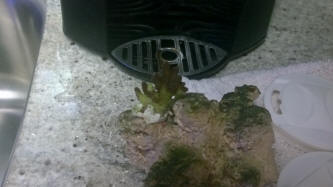
 |
|
Re: Coral Beauty
12/12/14
Hi Bob,
Bruce Here
<Heya>
Sorry about the size of the photos, did not realize the size of them from my
cell phone.
I believe you answered my question on the corals and even the fact that the
Coral Beauty Angel is picking when it was not before.
<Ahh!>
Data for tank
250 gallon display tank 72 x 26 x 30, 125 gallon sump, over flows at both ends
of display tank, two Aqua C, EV-240 skimmers at each end of sump. About 200
pounds of rock from previous tank plus one large flat piece to seed old rock.
There is total water volume of 300 gallons in system. Tank has gone thru cycle
all hair algae and cyno is gone. Only have thin hard green algae growing in
places and some purple coralline growing on bottom and a few rocks. Fish in tank
Kole Tang, Two Yellow Tangs, Tomini Tang, Coral Beauty, Dart fire fish, six line
wrasse.
Lighting is by 2 Orphek Atlantiks, using led is new to me. Granulated carbon
reactor, gfo reactor, biopellet reactor
S.G. 1.025 digital refractometer
PH 8.32
Temp 79.8 morning 81.2 nights
Calcium 420
Alkalinity 8.74 dKH
magnesium 1480
Phosphate .07
Nitrates are a bit high around 50
<Yeeikes; this is much more than a bit... s/b under 10 ppm for a reef>
Biopellet reactor added about 2 weeks ago.
<Do you have a carbon deficiency?>
Moved lights up about 6 inches as the spread was not enough and at the same time
the program was changed to less light. I think the lighting is the problem as
some of the corals started turning brown.
<Mmmm; can you move them up on the rock, closer to the light?>
I have had 4 corals that this has happened to and 2 of them so far are surviving
and look like they may be getting back some color and growing. To many changes
on an immature tank and coral stress.
<Yes, too. Review Scleractinian care on WWM please. BobF> |
Sponge Trouble (with Stony Corals), moved from FB 12/10/14
Morning Bob! I was wondering if I could pick your brain about chemical warfare
and corals.
I'm presently contending with a scenario where water parameters are spot on and
stable yet Euphyllia that once thrived are
now receding at a rapid rate. Upon removal the bases of 90% of the colonies were
found to be encrusted with numerous sponges.
Sponge tissue was scrubbed off and colonies were given an iodine dip. Now how to
contend with the remaining sponges that
have set up shop amongst the rock? Possible that the sponges are part of the
problem here? Am I losing my mind? Thanks Bob!
Jon Tarutis
House of Fins, a few seconds ago
Oh! Jon; pls send all petfish related mat. to me via Crew@WetWebMedia.comJust
cut/paste this. Ah yes; but/and do def. know of the
troubles w/ Euphylliids (and other stonies) and sponges (underneath). NEED to
removed the colonies and moved elsewhere.
Am cc'ing a friend (Cam Bee out working w/ Walt Smith in FJ and ChrisT who used
to, who both have extraordinary olfaction,
can/do smell the sponges... and reject specimens collected w/ them. Hopeful they
will share input w/ you here re.
Bob
LPS/Open Brain Troubleshooting Question
11/28/14
Happy Holidays WMM Crew!
<And you Brad>
First off, I'm happy to report per the Ick/Velvet outbreaks I had in my
new Angle butterfly tank about 9 months ago, all is well and has been
stable since I used Chloroquine to clear everything up! Thanks again for
the guidance, the fish are stunning and have settled right in.
<Ah welcome>
Today I have a question regarding my other tank, which is a 270 Reef
tank that has been running for about 4 years now. The issue that I've
been noticing for some time is that my open brain corals (Welso's, Tracs,
Fungia plate corals &c) become significantly shriveled once I bring them
home from LFS's and stay that way. They might be incredibly puffy/meaty
at the store, but at home (say even after a few weeks) they are not as
lively. They don't die, recede, or bleach, they just don't
expand and look as stunning as they do in the shops.
<A few possibilities.... lighting, water quality (something too much
and/or too little), or the usual allelopathy>
A few words on my setup. So this is a 270G Display (80Lx30Hx26D) with
100G fuge, 8 AI Sol lights, 2 MP 40's, powerful Reef Dynamic Skimmer,
and I am running biopellets and GFO.
<Ahh... the middle of the potentials above. DO you have measurable NO3
and HPO4? NEED these>
The LPS are at various spots on or
near the sand, they are far away from other corals, and none of my
fish/inverts bother them. I feed phyto
<Almost nothing, and none of the stony corals listed, eat/use this>
and meatier foods (target) usually twice a week. I also have a
ton of SPS, Zoanthids, cloves, and other encrusting corals throughout
the tank. Everyone else has been doing spectacular for years, strong
growth, bright colors &c.
<Oh! Then not a nutrient issue>
I just can't figure out why the open brains don't seem to like my tank.
Even when I feed I don't get much of a response from them.
<Back to the allelopathy>
A few notes on the parameters. Phosphates are nearly undetectable,
Nitrates are <10, Salinity is 1.025, Alk is around 9, Calcium 420, Mag
1300. PH is between 8.1-8.3 throughout the night/date. The flow doesn't
seem strong at all down by the LPS, I have some xenia near by and they
aren't being pushed around much. I've even tried putting them in my fuge
but that had no impact (or turning down the powerhead.) In terms
of light, my par meter says they are getting around 150 max, which seems
to be in their happy range.
<Yes; plenty>
The stores in my area have them between 60-90, but even when I've tried
moving them into that range it has no impact. I do 40 gallon water
changes usually once a week, and I dose Iodine and occasionally
strontium. I'm using Seachem Salinity for Salt, and RODI water with 0
TDS.
<Fine>
So I feel like I've exhausted all of my know how on this and couldn't
find a clear answer from research. A few things that I was wondering if
it would have any impact would be 1) the GFO?
<Possibly>
Not sure if it could be dusty and the LPS not liking it? I also don't
run any mechanical filtration (just protein skimmer) because it clogs so
easily. I was thinking about putting a filter sock on the GFO effluent
and filter pad in front of my return pump for a few days, but I know the
latter will clog quick so I can't do it long term. The other thing I was
wondering is if it could be from using the biopellets?
I'm using the Reef Dynamics reactor and it's plumbed right into my
skimmer. Just seems like a variable between my tank and the LFS'.
<Try removing one or both of these for a few weeks to see>
I was told my water could be too clean, but given that I have a ton of
fish in my reef and I feed heavily I find that hard to believe. Anyhow,
was wondering if you had any suggestions or could better point me in the
right direction? I'm considering sending off my water to a lab company
to have them test it, but no sure If that will provide much value, or
just be interesting to know.
As always I greatly appreciate your help! Hope you and yours have a
wonderful holiday season!
Brad
<Am asking that you read here:
http://wetwebmedia.com/CorlCompArt.htm
and as much of the linked files above as to gain insight... And possibly
try a couple units of Chemipure in your filter flow path... and, really,
consider moving the mal-affected LPS elsewhere for a while to discount
the poss. that they're being influenced by the Zoanthids, Xenia... Bob
Fenner>
Re: LPS/Open Brain Troubleshooting Question
11/29/14
Thanks Bob for the lightning fast response over the holidays no less!
<I work every day the sun comes up!>
A few quick responses.
1. There are detectable levels of Nitrate and Phosphate, between 5-10ppm
of Nitrate and maybe .03 of phosphate. I would imagine more than enough
of what they need.
<Ah good; yes>
2. Your suggestion of allelopathy certainly intrigues me. I
didn't think that would be a problem given the distance between the
brains and the SPS.
<Not the SPS that are trouble>
I know that some corals like leathers can shed (which I don't have any)
but I thought as long as they were not in proximity (including
sweeper tentacles) it should be fine.
<Ah no... Zoanthids, Corallimorpharians, Gorgonaceans... many species
are chemical warfarers>
What's the best way to test this hypothesis?
<Selective removal of suspected perpetrators, mal-affecteds>
Would running carbon or ozone help?
<Yes... a high and steady ORP (low 400s) would be great>
I guess I could remove the corals--unfortunately I can't put the open
brains in my angel tank :) so I might need to find them a new home.
3. Do you think having a relatively heavy bioload could impact them?
<Not negatively; no... many of these species live in the mud, muck in
the wild>
I do have a lot of fish and feed somewhat heavily, but I do compensate
with powerful skimming and water changes (and as mentioned, I have lie
15 different kinds of SPS/Acros and those are happy.)
Thanks again for your guidance and suggestions, no urgency on a
response, please enjoy your Thanksgiving!
Best Regards,
Brad
<And you! BobF>
Acro and disc coral sudden bleaching
10/31/14
Hi guys,
I have been having problems with coral bleaching,
<Having read the rest of your msg., some very real possible causes here>
it started about 6 weeks ago with disc coral slowly deteriorating over a
few days. After I had lost 2 discs I noticed my peppermint shrimp
sitting on one of the remaining discs and I thought it was likely the
shrimp had either eaten the discs or annoyed them to the point of death.
<More likely just eating after they were going>
I then lost 2 large Acro colonies within a week of each other. They
bleached but from the middle out as opposed to from the tips towards the
center. I did several large water changes but am now losing the last two
Acro colonies. The smaller of the two looked fine yesterday but today is
completely bleached. The other larger colony is not as badly bleached
but its noticeable. This time the bleaching looks to be happening from
the tips towards the centre.
I had assumed there must be a problem with water quality but my tests
(confirmed by lfs) are all ok
Sg: 1.036
Nitrate: 0
Phosphate: 0 - .25
<Chemo-auto-trophs need both NO3 and HPO4... they're starved>
Kh: 8
Calcium: 600 + (higher than I would have expected)
<This alone could kill them... see WWM re Ca and Mg proportionality>
Tank: 400L + sump
Lighting: t5 vho 4× actinic 4x white 2x pink (8 hours) plus led
moonlights
Tank is about 2 years old. Live rock came from a saltwater tank I'd had
for about 18 months before that.
I make the saltwater with red sea coral salt, marine buffer, trace
elements, and ro/di water. Let it mix for 24 hours before using.
All morphs, plate coral, cabbage coral, hammer coral and cactus coral
are ok.
Livestock: blue spot tang, pair of clowns, foxface, coral beauty,
mandarin fish, hippo tang, scooter blenny, peppermint shrimp and cleaner
shrimp are also doing fine. Also have 2x btas (fine) and a squamosa clam
(also fine), several Featherdusters (looking happy).
I am not sure if there is a problem with the water, i.e. something I
haven't tested for, the lighting (too long or too short photoperiod) or
a pest. I changed the lights 3-4 months ago. I changed 1-2 bulbs at a
time however did not have pinks in before, could this be a problem?
<Not likely>
If it helps to know the Acro colonies were not placed in terribly close
proximity to each other and I have one disc coral that has escaped
unscathed (so far). This discs were all sitting on the sandbed and I
can't see why I have lost all but one of them.
What do you think is causing the trouble?
<The lack of chemical food; the too high and disproportionate [Ca]>
I am not running carbon, should I be?
<Possibly; on a punctuated basis; look up C use on WWM>
I tend to skim wet but have noticed the skimmer is not pulling out as
much gunk as usual. I've cleaned adjusted and fiddled with it but still
not much coming out.
Please help.. I don't want to buy any new coral before I know how to fix
whats going on and things are looking pretty sad at the moment.
--
<Read on! Bob Fenner>
Help Brown Jelly is attacking! Too bz/lazy to search WWM
3/21/14
Hi my name is Rich and I have a local fish store helping me set up my
salt aquarium. Brown jelly has just killed my hammer coral and I think
it might be affecting my other corals. Does it spread fast? I have a
Kenya tree, Zoanthid and a frogspawn all newish meaning I got them and
set my tank up about a month ago. Any help? My Kenya has been down
sideways for 3 days now. Also I have treated my other frogspawn twice
now.
Can you call or text me so I can give more description?
<Mmm; nope. But we have hundreds of citations, even a Brown Jelly FAQs
file you can/could search on WWM.
Bob Fenner>
Re: Help Brown Jelly is attacking!
I understand there are threads but I need some guidance on
there where abouts. I can't seem to locate them.
Thanks,
-Rich
Re: Help Brown Jelly is attacking! 3/22/14
I cannot seem to find them. Can you give me a general where about to
find the threads?
<? READ HERE:
http://wetwebmedia.com/faqstips.htm
Put the three words "brown jelly disease" in the search tool... On every
page on WWM... B>
Thanks
-Rich
|
brown jelly disease
3/7/14
To whomever this may concern,
I am currently dealing with brown jelly disease. It wiped out my small
hammer and much of my abundant frogspawn. I am nearly positive that is
what it is, because I literally saw multiple heads melt away
into a brown goo and half my coral was gone in a day and a half (i have
tons of frogspawn in my tank). Water parameters were good
(alkalinity was lower than I would like at 8.0 but I started dosing
afterwards), but I used my remaining mixed water to do a large water
change following the removal of the affected corals. I am not sure how
this "parasite" got in my tank since I haven't added anything in a long
time, but I am guessing my corals were susceptible because they are so
big now that they come out of the water during water changes and a bit
of the coral flesh tears on the sharp skeleton as it hangs for a few
minutes.
<Mmm; well; this symptom has an unknown etiology (causative
mechanism)...
Is there a principal organism; ciliates, bacteria, involved directly?...
Do read here re:
http://aquariumcoraldiseases.weebly.com/brown-jelly-syndrome-bjs.html>
Anyways, I now have like 4 small colonies of frogspawn left ( I
completely scrapped 3, including my largest one in hopes of saving the
rest) and none of the have melting heads or brownish jelly. Two of
the colonies seem to be receding a bit at the base and have some
encrusted ulcerating lesions around parts of the base. Attached is a
picture of one of them that happens to be close to the glass; you can
see the fleshy part is receding at the base and there are these
ulcerating lesions on it. I am paranoid that this is somehow related to
the brown jelly issue and am wondering what I should do since it is the
base of the coral being affected and I don't exactly have mixed water at
the moment to do any sort of Lugol's dips with (mixing more tomorrow).
in the meantime, I am keeping water quality in tip top shape and am
testing Ph, temperature, alkalinity, calcium, and salinity daily and
nitrates every few days. Any impressions or advice on whats going on
with these lesions would be greatly appreciated. Thank you for your time
and help, it is very appreciated.
Sincerely,
Gabby N
<Likely the stock Metronidazole treatment is a good move. Bob Fenner>
|
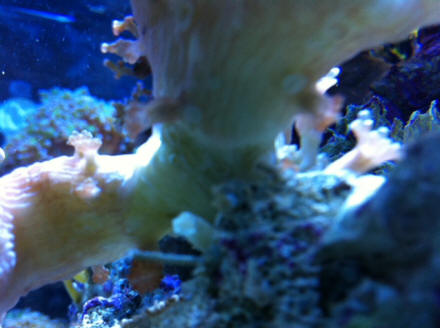 |
|
|

